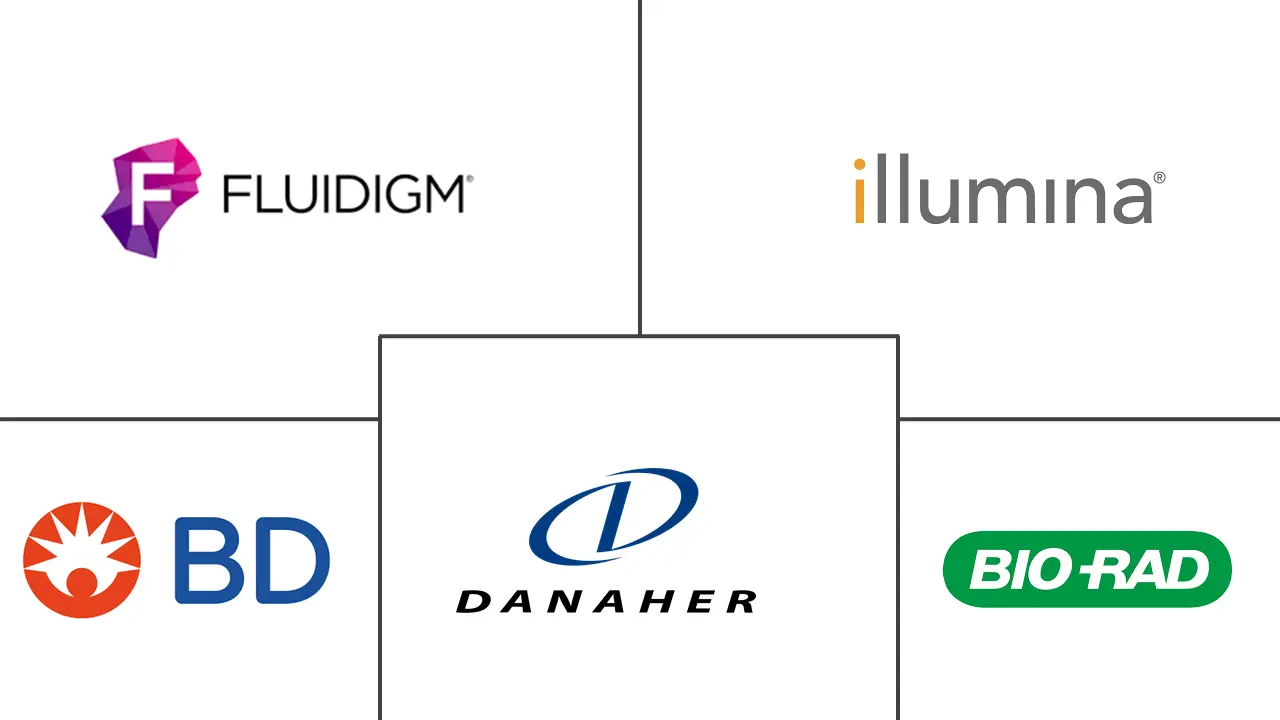Global Single Cell Analysis Market Size and Share
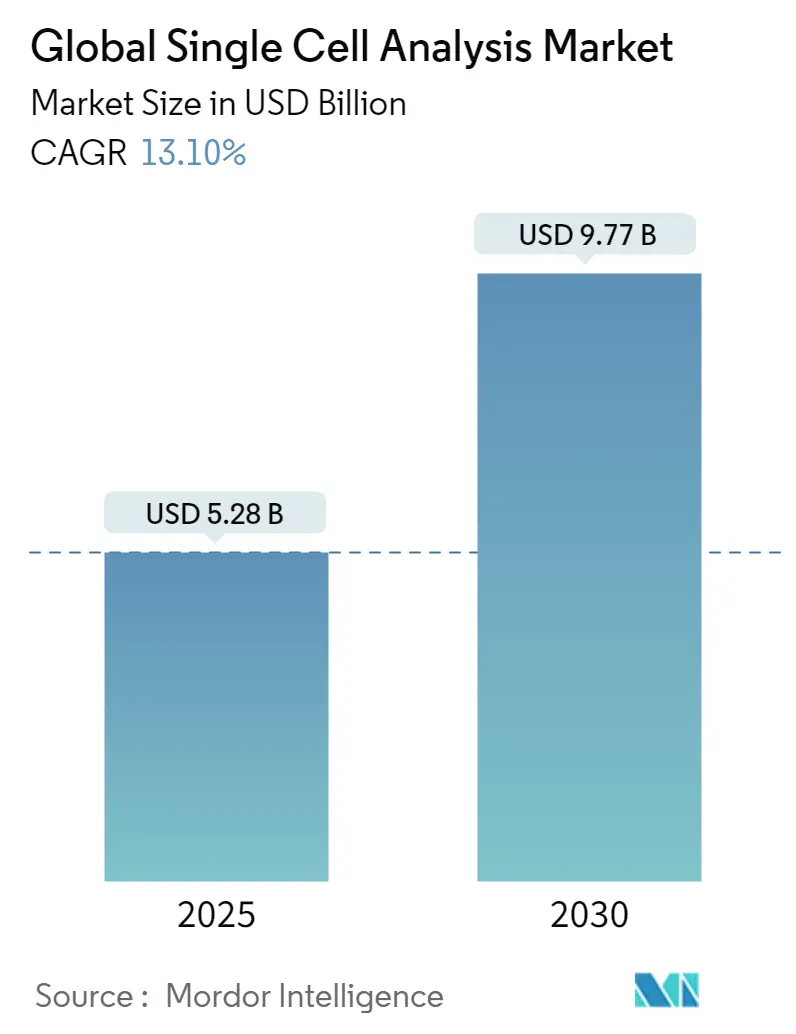
Global Single Cell Analysis Market Analysis by Mordor Intelligence
The single cell analysis market is valued at USD 5.28 billion in 2025 and is forecast to climb to USD 9.77 billion by 2030, registering a 13.10% CAGR over the period. Expanding precision-medicine programs, a widening cancer and autoimmune disease burden, and active government and venture capital funding are sustaining double-digit growth. Rapid advances in single-cell multi-omics, AI-enabled bioinformatics, and spatial transcriptomics are opening new clinical and research use cases, while recurring consumables sales maintain predictable cash flows for suppliers. Strategic consolidation among large instrumentation firms and focused innovators is accelerating integrated workflow rollouts, and region-specific regulatory frameworks are beginning to accommodate diagnostic assays based on single-cell readouts.
Key Report Takeaways
- By product, consumables led with 58.12% revenue share in 2024; instruments are projected to expand at 14.50% CAGR to 2030.
- By technique, flow cytometry captured 34.45% of single cell analysis market share in 2024, whereas next-generation sequencing is set to grow at a 13.70% CAGR through 2030.
- By cell type, human cells accounted for 61.32% share of the single cell analysis market size in 2024; microbial cells are advancing at a 14.30% CAGR to 2030.
- By workflow, the single-cell analysis step held 46.17% share in 2024, while data analysis and management is accelerating at 13.90% CAGR.
- By application, research commands 67.84% revenue share; medical and clinical use is expanding at a 14.20% CAGR to 2030.
- By end user, academic and research laboratories contributed 46.52% in 2024; biotechnology and pharmaceutical companies record the highest projected CAGR at 13.80%.
- By geography, North America dominated with 42.19% share in 2024, whereas Asia-Pacific is forecast to post a 14.50% CAGR between 2025-2030.
Global Single Cell Analysis Market Trends and Insights
Drivers Impact Analysis
| Driver | (~) % Impact on CAGR Forecast | Geographic Relevance | Impact Timeline |
|---|---|---|---|
| Precision and personalized medicine adoption | +2.5% | North America, Europe, Global | Long term (≥ 4 years) |
| Multi-omics funding for precision oncology | +1.8% | North America, Europe, Emerging APAC | Medium term (2-4 years) |
| Rising cancer and immune-mediated disorders | +1.2% | Global, higher in aging regions | Long term (≥ 4 years) |
| Government and venture-capital investments | +1.5% | North America, Europe, China, Japan | Medium term (2-4 years) |
| AI-enabled bioinformatics platforms | +0.9% | Developed markets first, Global thereafter | Short term (≤ 2 years) |
| Spatial transcriptomics integration | +1.5% | North America, Europe, Advanced APAC | Medium term (2-4 years) |
| Source: Mordor Intelligence | |||
Expanding Adoption of Precision and Personalized Medicine
Clinical programs increasingly rely on single-cell technologies to resolve cellular heterogeneity that limits bulk-omics approaches. Oncology illustrates the shift: single-cell RNA sequencing is identifying resistant tumor clones and refining immunotherapy selection, driving 35% gains in response-prediction accuracy [1]National Institutes of Health, “Single Cell Analysis Program,” nih.gov. Growing integration into routine workflows across major cancer centers positions the single cell analysis market for sustained long-term demand.
Surge in Single-Cell Multi-Omics Funding for Precision Oncology
Venture investment in startups that combine genomic, transcriptomic, and proteomic readouts at single-cell resolution surpassed USD 50 billion in 2024. Platforms delivering simultaneous DNA, RNA, and protein panels from a single cell are accelerating biomarker discovery and patient-stratification pipelines, reinforcing near-term commercial uptake.
Increasing Prevalence of Cancer and Immune-Mediated Disorders
Projected 47% growth in global cancer incidence by 2040 is magnifying demand for precise tumor profiling. Single-cell methods detect rare oncogenic or immune cell subpopulations that traditional diagnostics overlook, improving prognostic accuracy to 85% in melanoma cohorts.
Escalating Government and Venture-Capital Funding
More than USD 500 million in NIH grants and frequent USD 100 million-plus private rounds are accelerating product commercialization and broadening access to advanced platforms, mainly in North America, Europe, China, and Japan.
Introduction of AI-Enabled Bioinformatics Platforms
AI algorithms now automate cell-type annotation and trajectory inference, tackling terabyte-scale datasets that previously required specialized bioinformaticians. Early adopters report analysis-time cuts of up to 70% and reduced bottlenecks in clinical assay development.
Emergence of Spatial Transcriptomics Platforms Integrating Imaging + RNA-seq
Technologies that retain tissue context while mapping gene expression are illuminating tumor-microenvironment interactions, a critical factor in therapy design. Spatial workflows are gaining traction in oncology and neuroscience laboratories across the United States, Germany, Japan, and China.
Restraints Impact Analysis
| Restraint | (~) % Impact on CAGR Forecast | Geographic Relevance | Impact Timeline |
|---|---|---|---|
| High capital and maintenance costs | −1.5% | Emerging markets most affected | Medium term (2-4 years) |
| Shortage of trained bioinformaticians | −1.2% | APAC and MEA particularly | Short term (≤ 2 years) |
| Data-privacy compliance hurdles (GDPR, HIPAA) for cloud-based single-cell repositories | -0.9% | Europe and North America in the lead, global impact as cross-border projects grow | Short term (≤ 2 years) |
| Data-management, storage, and cybersecurity challenges | −0.8% | Global | Medium term (2-4 years) |
| Source: Mordor Intelligence | |||
High Upfront Capital Expenditure and Maintenance Costs
Advanced spatial-omics instruments often list above USD 500,000, with annual service contracts adding 10-15% of ownership cost. High consumable prices, ranging USD 500–2,000 per sample, limit adoption outside well-funded centers, especially in Latin America, Africa, and parts of Southeast Asia [2]Oxford Nanopore Technologies, “Capital Markets Day 2023 Presentation,” storyblok.com.
Shortage of Trained Bioinformaticians for Giga-Scale Datasets
Two-thirds of research institutions report recruitment delays exceeding six months for data-science roles, hindering deployment of complex single-cell studies. Talent gaps are sharpest in emerging Asian and Middle-East hubs, prompting increased automation and online training initiatives [3]National Bioinformatics Infrastructure Sweden, “NBIS Strategic Plan 2025–2029,” nbis.se .
Data-Management, Storage, and Cybersecurity Challenges
Experiments profiling 10, 000 cells can generate 500 GB raw data. Institutions lacking robust IT infrastructure delay projects or scale back throughput, particularly when handling protected patient information. Cloud-native platforms are gaining favor but add subscription costs.
Segment Analysis
By Product: Consumables Sustain Recurring Revenue Streams
The consumables segment accounted for 58.12% of 2024 revenue as laboratories repeatedly purchase reagents, chips, and assay kits essential for routine workflows. Continuous demand for library-prep reagents anchors predictable income and lowers sensitivity to macroeconomic swings in instrumentation budgets. Instrument sales, although a smaller base, are projected to grow 14.50% CAGR owing to launches that combine multi-omic readouts in single runs. Automated liquid-handling and robotics modules that streamline high-throughput processing are also raising capital-equipment appeal.
Consumable manufacturers are pivoting toward integrated workflow bundles that pair reagents with software and technical support, deepening customer lock-in. Broad-portfolio firms capture cross-selling advantages, whereas niche reagent suppliers seek partnerships for full-solution offerings. The single cell analysis market size for instruments is set to expand rapidly as spatial-omics and combined DNA-RNA-protein analyzers move from prototype to commercial release.
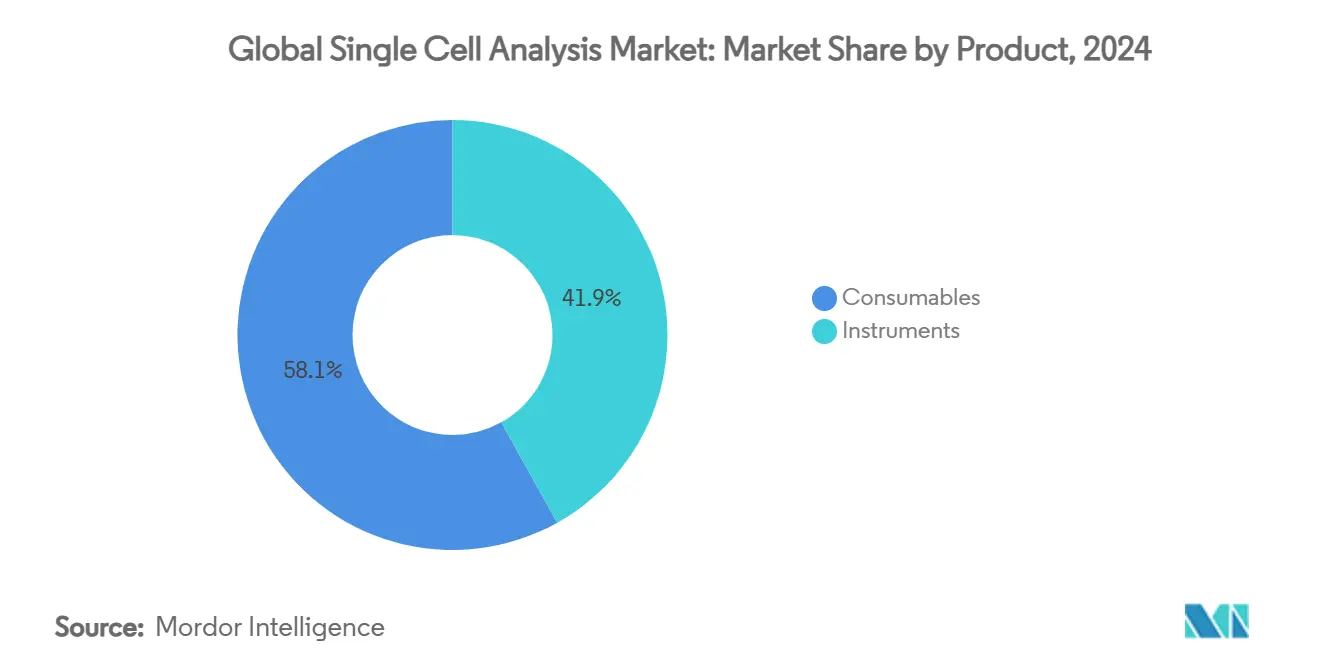
By Technique: Next-Generation Sequencing Redefines Analytical Possibilities
Flow cytometry retained 34.45% revenue share in 2024 on the strength of established adoption in clinical immunology, transplantation, and blood-cancer labs. Continuous detector and fluorophore upgrades permit 40-plus-parameter panels, bolstering utility. Next-generation sequencing is the fastest-growing technique, forecast at 13.70% CAGR, as falling per-gigabase costs and cell-barcoding chemistries unlock high-content transcriptomic profiling. The single cell analysis market sees PCR, microscopy, mass spectrometry, microfluidics, and RNA-FISH occupying specialized niches. Mass-spectrometry-based single-cell proteomics is bridging transcript-to-protein gaps, while spatial transcriptomics combines imaging with sequencing to add microenvironment insights.
By Cell Type: Human Cells Dominate Clinical Research Applications
Human cells provided 61.32% of 2024 revenue, reflecting direct translational relevance. Oncology, neurology, and immunology depend heavily on patient-derived samples to capture disease heterogeneity. Microbial single-cell work, advancing at 14.30% CAGR, is unveiling microbiome functions in metabolic and inflammatory disorders. Animal models remain central to preclinical pipelines, and plant-cell studies, though smaller, are growing in agricultural biotech. Improved preservation and isolation protocols are expanding human clinical sample throughput, narrowing bench-to-bedside gaps. The single cell analysis market size attributed to microbial workflows is projected to swell as low-input chemistries overcome bacterial cell-wall hurdles.
By Workflow Step: Data Analysis Emerges as Critical Bottleneck
Single-cell analysis proper delivered 46.17% of 2024 revenue, covering cytometry, sequencing, and imaging. However, the data analysis and management segment is expanding at 13.90% CAGR as laboratories grapple with tera-scale datasets. Cloud-hosted platforms offering automated QC, clustering, and visualization are replacing home-grown pipelines. Sample-prep and cell-isolation advances are also pivotal; closed-cartridge systems now reduce hands-on time and variability, lifting reproducibility. Integrated end-to-end platforms are a competitive focal point, with co-developed solutions cutting total workflow time to under 10 hours.
By Application: Clinical Adoption Accelerates
Research dominated with 67.84% share in 2024, spanning oncology, stem-cell biology, immunology, and neuroscience. Clinical and medical uses are expanding at 14.20% CAGR as regulatory frameworks mature. Oncology diagnostics lead clinical uptake, driven by minimal residual disease detection and immunotherapy response monitoring. Prenatal screening and infectious-disease assays are burgeoning subsegments. AI-augmented interpretation is shortening the learning curve for pathologists evaluating complex multi-omic signatures. The single cell analysis market is thus shifting from exploratory science toward routine patient management.
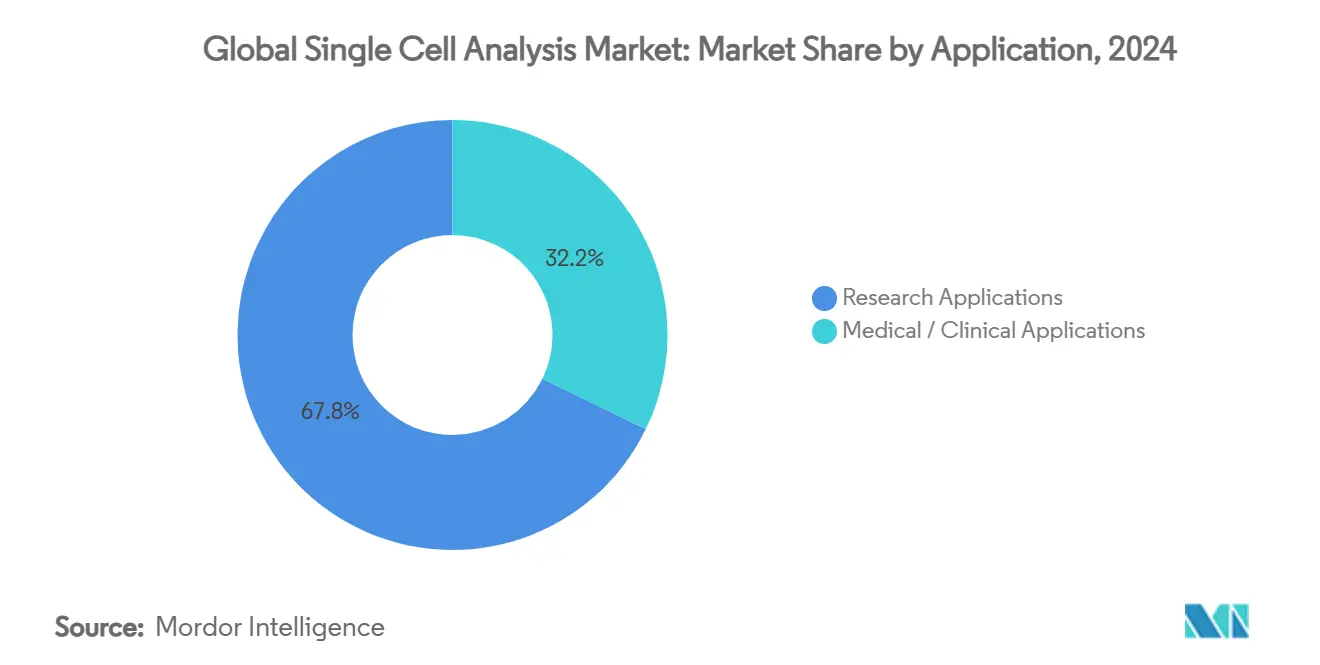
By End User: Academic-Industry Partnerships Drive Innovation
Academic institutions held 46.52% revenue share in 2024, serving as early-adoption and innovation hubs. Biotech and pharmaceutical firms, growing at 13.80% CAGR, are integrating single-cell platforms into target discovery, lead-optimization, and patient-stratification studies. Diagnostic laboratories are gradually onboarding single-cell assays for clinical reporting, especially in hematologic malignancies. Contract research organizations are scaling capacity to deliver outsourced single-cell services, enabling smaller firms to access advanced capabilities without large capital spend.
Geography Analysis
North America contributed 42.19% revenue in 2024, supported by NIH funding, a dense network of cancer centers, and headquarters of global market leaders such as Thermo Fisher Scientific, Illumina, and 10x Genomics. FDA engagement with lab-developed single-cell diagnostics is fostering regulatory clarity. Regional collaborations between academic health systems and industry accelerate translational pipelines. The single cell analysis market size in North America is expected to keep expanding as reimbursements for molecular diagnostics broaden.
Asia-Pacific is forecast to post the fastest 14.50% CAGR through 2030. China’s precision-medicine initiatives, Japan’s engineering strengths, and India’s expanding biotech sector underpin demand. National research grants and favorable approval pathways for in-vitro tests are catalyzing local production of consumables and instruments. Regional governments are also investing in cloud infrastructure to cope with data-management demands.
Europe maintains a sizeable share led by Germany, the United Kingdom, and France. Horizon Europe grants fuel multi-center research, while the In-Vitro Diagnostic Regulation tightens performance-evidence requirements, influencing product designs. Smaller but growing adoption in the Middle East and South America reflects increasing healthcare modernization and genome-surveillance programs. Addressing cost barriers and workforce gaps will determine uptake pace across these emerging territories.
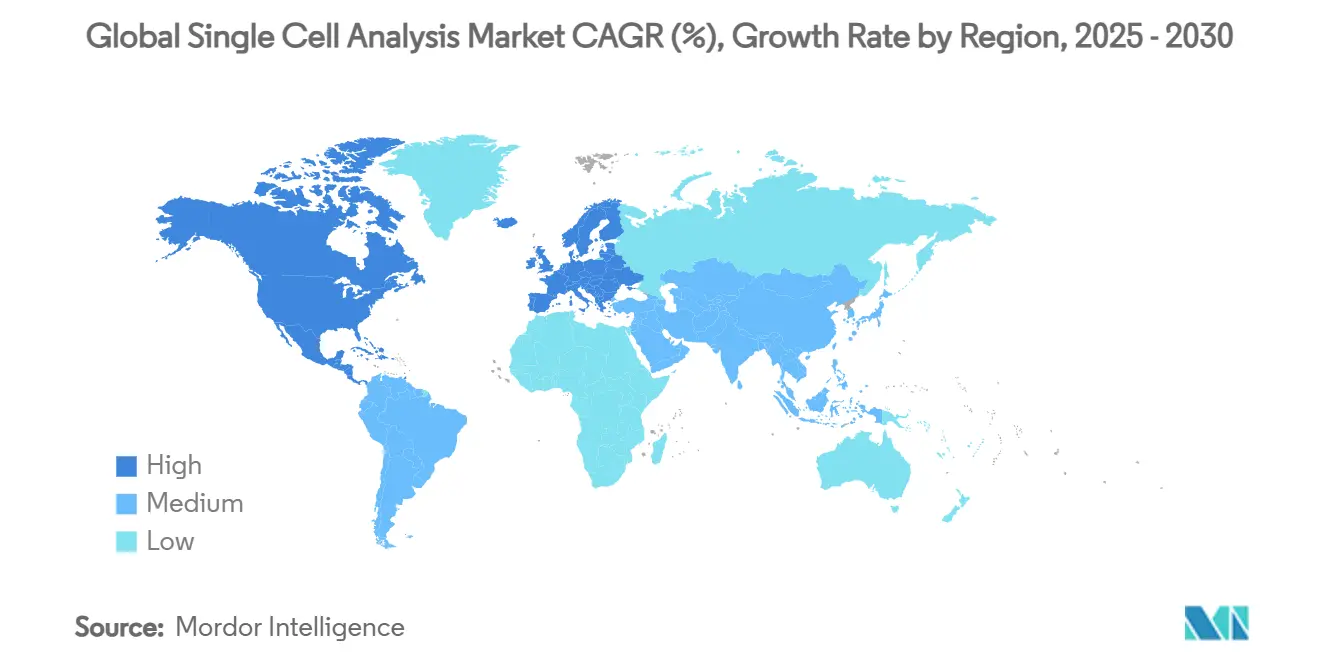
Competitive Landscape
The single cell analysis market is moderately concentrated. Diversified instrument companies—Thermo Fisher Scientific, Becton Dickinson, and Illumina—combine broad portfolios with global distribution, while specialists such as 10x Genomics and Parse Biosciences focus on high-throughput multi-omic and spatial solutions.
Acquisition activity remains brisk; Qiagen’s 2023 purchase of Genoox expanded clinical-grade genomic capabilities. Competitive differentiation centers on integrated workflows covering sample prep to AI-assisted interpretation.
AI software developers and cloud providers are new entrants, partnering with assay vendors to tackle data bottlenecks. Opportunities persist for developers of cost-controlled, clinical-grade assays aimed at oncology and infectious-disease diagnostics.
Global Single Cell Analysis Industry Leaders
-
Bio-Rad Laboratories Inc.
-
Illumina Inc.
-
Beckman Coulter Inc. (Danaher Corporation)
-
Becton, Dickinson, and Company
-
Fluidigm Corporation
- *Disclaimer: Major Players sorted in no particular order
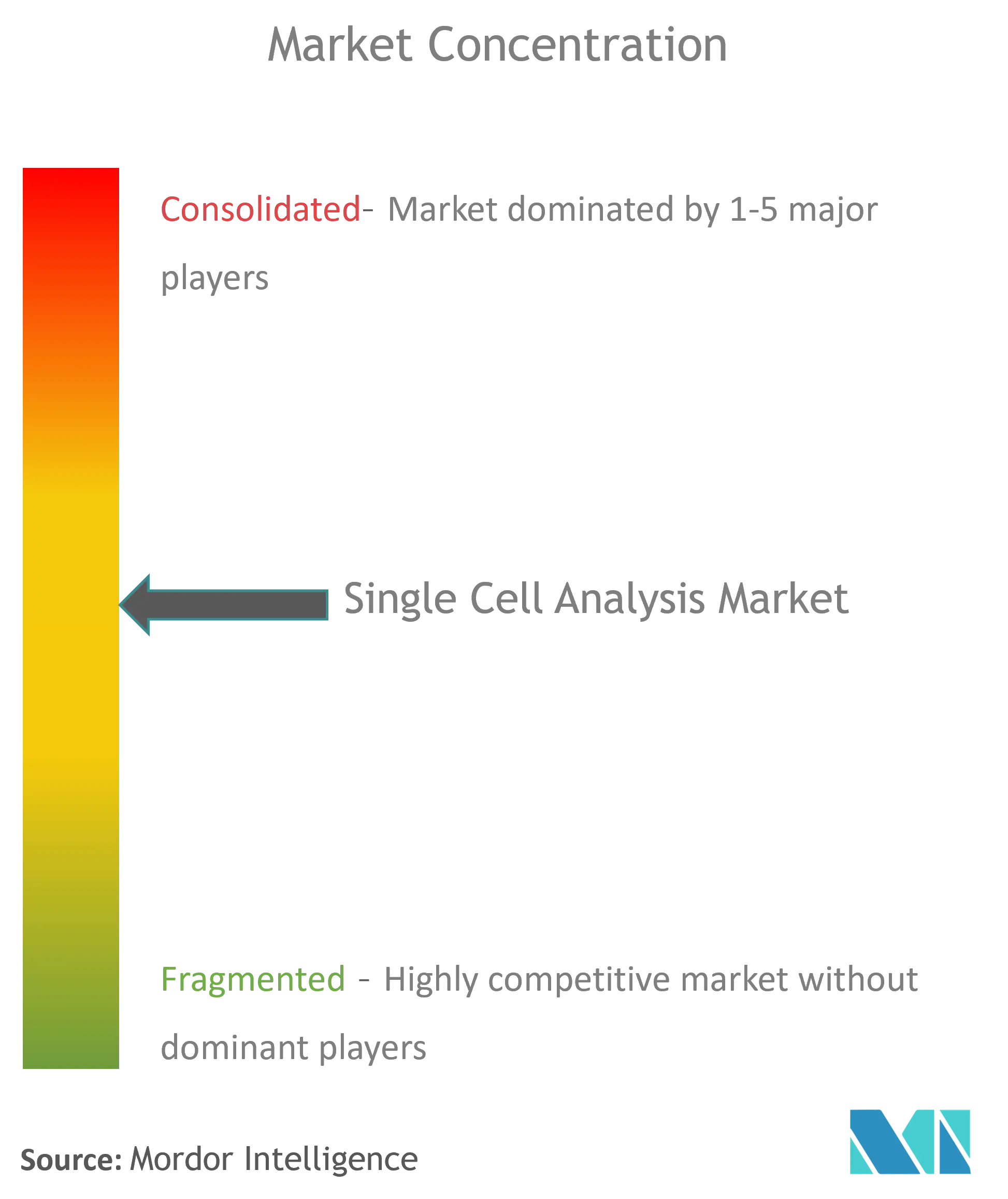
Recent Industry Developments
- April 2025: BioSkryb Genomics and Tecan Group introduced a high-throughput single-cell workflow that delivers sequencing-ready libraries in under 10 hours, supporting scalable multi-omics research.
- August 2024: Beckman Coulter Life Sciences and Illumina launched the TruSight Oncology 500 DNA/RNA assay on the Biomek NGeniuS System, compressing library prep to under three days.
- February 2024: 10x Genomics released GEM-X assays for single-cell gene expression and immune profiling, broadening its product family.
- February 2024: Takara Bio USA launched Shasta Total RNA-Seq and Whole-Genome Amplification kits for single-cell workflows.
Global Single Cell Analysis Market Report Scope
As per the scope of this report, single-cell analysis refers to the study of individual cells isolated from tissues in multicellular organisms. The study of living cells can increase the understanding of the interconnecting molecular events that are continually taking place within each cell. The single-cell analysis market is segmented by technique, application, end-user, and geography. By technique, the market is segmented into flow cytometry, next-generation sequencing, polymerase chain reaction (PCR), microscopy, mass spectrometry, and other techniques. By application, the market is segmented into research applications and medical applications. By end-user, the market is segmented into academic and research laboratories, biotechnology and pharmaceutical companies, and hospital and diagnostic laboratories. By geography, the market is segmented into North America, Europe, Asia-Pacific, Middle-East and Africa, and South America. The market report also covers the estimated market sizes and trends for 17 different countries across major regions, globally. The report offers the value (in USD million) for the above segments.
| Consumables |
| Instruments |
| Flow Cytometry |
| Next-Generation Sequencing |
| Polymerase Chain Reaction (PCR) |
| Microscopy |
| Mass Spectrometry |
| Microfluidics |
| RNA-FISH |
| Other Techniques |
| Human Cells |
| Animal Cells |
| Microbial Cells |
| Plant Cells |
| Sample Preparation |
| Cell Isolation & Sorting |
| Single-Cell Analysis |
| Data Analysis & Management |
| Research Applications | Stem Cell Research |
| Neuroscience | |
| Immunology | |
| Oncology | |
| Microbiology | |
| Other Research Applications | |
| Medical / Clinical Applications | Prenatal Testing |
| In Vitro Fertilization | |
| Infectious Disease Diagnostics | |
| Oncology Diagnostics |
| Academic & Research Laboratories |
| Biotechnology & Pharmaceutical Companies |
| Hospital & Diagnostic Laboratories |
| Contract Research Organizations (CROs) |
| North America | United States |
| Canada | |
| Mexico | |
| Europe | Germany |
| United Kingdom | |
| France | |
| Italy | |
| Spain | |
| Rest of Europe | |
| Asia-Pacific | China |
| Japan | |
| India | |
| South Korea | |
| Australia | |
| Rest of Asia-Pacific | |
| Middle East | GCC |
| South Africa | |
| Rest of Middle East | |
| South America | Brazil |
| Argentina | |
| Rest of South America |
| By Product | Consumables | |
| Instruments | ||
| By Technique | Flow Cytometry | |
| Next-Generation Sequencing | ||
| Polymerase Chain Reaction (PCR) | ||
| Microscopy | ||
| Mass Spectrometry | ||
| Microfluidics | ||
| RNA-FISH | ||
| Other Techniques | ||
| By Cell Type | Human Cells | |
| Animal Cells | ||
| Microbial Cells | ||
| Plant Cells | ||
| By Workflow Step | Sample Preparation | |
| Cell Isolation & Sorting | ||
| Single-Cell Analysis | ||
| Data Analysis & Management | ||
| By Application | Research Applications | Stem Cell Research |
| Neuroscience | ||
| Immunology | ||
| Oncology | ||
| Microbiology | ||
| Other Research Applications | ||
| Medical / Clinical Applications | Prenatal Testing | |
| In Vitro Fertilization | ||
| Infectious Disease Diagnostics | ||
| Oncology Diagnostics | ||
| By End User | Academic & Research Laboratories | |
| Biotechnology & Pharmaceutical Companies | ||
| Hospital & Diagnostic Laboratories | ||
| Contract Research Organizations (CROs) | ||
| By Geography | North America | United States |
| Canada | ||
| Mexico | ||
| Europe | Germany | |
| United Kingdom | ||
| France | ||
| Italy | ||
| Spain | ||
| Rest of Europe | ||
| Asia-Pacific | China | |
| Japan | ||
| India | ||
| South Korea | ||
| Australia | ||
| Rest of Asia-Pacific | ||
| Middle East | GCC | |
| South Africa | ||
| Rest of Middle East | ||
| South America | Brazil | |
| Argentina | ||
| Rest of South America | ||
Key Questions Answered in the Report
How big is the Global Single Cell Analysis Market?
The Global Single Cell Analysis Market size is expected to reach USD 5.28 billion in 2025 and grow at a CAGR of 13.10% to reach USD 9.77 billion by 2030.
What factors are driving the rapid growth of the single cell analysis market?
Precision-medicine adoption, rising cancer incidence, and sustained public- and private-sector funding are the primary growth catalysts, pushing the market toward a 13.10% CAGR through 2030.
Who are the key players in Global Single Cell Analysis Market?
Bio-Rad Laboratories Inc., Illumina Inc., Beckman Coulter Inc. (Danaher Corporation), Becton, Dickinson, and Company and Fluidigm Corporation are the major companies operating in the Global Single Cell Analysis Market.
Why is Asia-Pacific the fastest-growing regional market?
Large government precision-medicine programs, expanding research infrastructure, and favorable approval pathways are propelling Asia-Pacific at a projected 14.50% CAGR.
Which region has the biggest share in Global Single Cell Analysis Market?
In 2025, the North America accounts for the largest market share in Global Single Cell Analysis Market.
Page last updated on:
